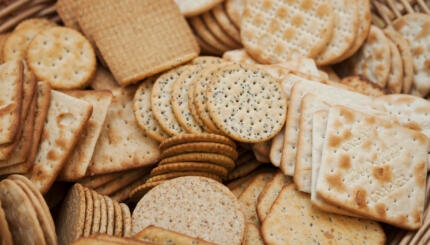Earlier this week, Sue Fishkoff wrote about watching a goat slaughtered and people who only keep kosher on holidays. She is the author of Kosher Nation: Why More and More of America’s Food Answers to a Higher Authority
.
The most fascinating work of kosher food manufacturing takes place in the middle of the night. That’s when factories shut down their lines for koshering, when ovens are blasted with blowtorches and boiling water is run through miles of pipes and in and out of huge stainless steel vats.
That’s when the mashgiachs, or kosher supervisors, start work in industrial kitchens and banquet halls, cleaning bugs from pounds of lettuce, celery and other fresh produce.
And that’s when the flour for Manischewitz kosher-for-Passover matzah begins its journey from western Pennsylvania to the company’s $15 million manufacturing facility in Newark, NJ.
Matzah is important to Manischewitz. The 120-year-old company makes a wide range of kosher products, but it was founded in 1888 to produce kosher for Passover matzah on a new assembly line format, and matzah is still central to its mission. Like most ethnic kosher food manufacturers, Manischewitz’s busiest season is Passover. Fifty percent of its business involves kosher-for-Passover food. According to one survey, 24 percent of American non-Jewish consumers bought a Manischewitz product during the previous year; most of them bought matzah.
Passover matzah is the most labor-intensive kosher product in the world. As one of two sacramental foods required at the seder table, along with wine, its production is carefully controlled to ensure that water only comes into contact with the flour for less than 18 minutes. Longer than that and, according to rabbinic authorities, leavening might begin. That would mean it cannot be eaten at all during the eight-day Passover holiday.
In industrial production, the flour must be watched by a mashgiach from the time the wheat is milled until water is introduced to the flour during the mixing process. At that point the dough remains under even closer supervision to make sure it is completely baked in less than 18 minutes.
A Manischewitz Passover matzah begins its life in a wheat field in one of the mid-Atlantic states. The exact location is a trade secret. Red winter wheat is the preferred variety for unleavened bread because it is low-protein; protein in the dough produces air pockets that cause it to rise during baking.
The wheat is harvested and brought to another undisclosed location, a family-owned flour mill in rural western Pennsylvania where it is stored for up to three weeks before being ground into flour. A single wheat kernel moves through the grinding and sifting process in about 20 minutes. The milled flour is kept utterly dry in moisture-resistant bins, until it can be transferred to a tanker truck for the three-hour journey to Newark.
I spent a morning with Rabbi Yoel Lowenstein, mashgiach at the flour mill, as he met a freshly washed tank truck that pulled up at the mill shortly before dawn. He crawled inside the enormous steel tank with a flashlight to check for moisture. Running his hand along the curved sides, hepeered at the floor and felt carefully under the jagged metal rim. Then he crawled back out and climbed the stairs to the loading platform. The truck pulled up underneath the platform, and Lowenstein watched as close to 50,000 pounds of flour was pumped at high-speed into the intake valve atop the tanker. At one point he leaped down and scooped out a few plastic bags of flour, which the driver had to carry to Newark where it would be checked for moisture levels.
When the tanker was full, Lowenstein stretched plastic wrap over the 18-inch valve opening to seal it tight, replaced the heavy metal hatch, and closed it with yellow Orthodox Union plastic seals. He placed similar seals on the discharge valves, from which the flour will be pumped out. The seals can only be removed by another mashgiach after the truck arrives at the Newark plant. If even one seal is compromised during the journey, so is the flour’s integrity. Once, a truck carrying Passover flour to Newark got a flat tire, and the impact blew out one of the seals. The entire 50,000-pound load was rejected by Manischewitz.
After the flour arrives in Newark, it is stored in a large outdoor silo for no longer than a few days. Then it’s pumped into the plant for mixing and baking, a procedure that is timed to the second. Rabbi Yaakov Horowitz, longtime head rabbi at Manischewitz and a worldwide authority on Passover production and kosher food, guided me around the plant, pointing out the state-of-the-art matzah baking line he helped design. In the mixing room, he showed off the double kettle system imported from Israel. Flour is dumped down a chute into one kettle, then water is added through a thin
yellow tube and the mixture is agitated until it forms a sticky dough that is extruded onto a conveyor belt to begin its short run to the ovens.
Batches of dough are mixed up and dropped every minute for 14 minutes. Then an alarm sounds, the kettles are rotated automatically, and the first kettle is thoroughly cleaned while the second kettle repeats the process.
Before each batch of dough hits the conveyor belt, a mashgiach monitoring the mixing grabs an egg-sized amount called challah, meaning “tithe,” and throws it in a bin for later discarding, according to Jewish law. The rest of the dough moves over and under a series of metal rollers that press it into thinner and thinner sheets, until the dough is ¼=inch thick. A final perforating roller scores it into matzah-sized squares, and adds tiny holes to ensure a thorough bake .
The dough hits the 700-degree oven between 11-14 minutes after the flour and water are first mixed. The legal limit is 18 minutes, but the company gives itself some wiggle room. If the system breaks down and the dough does not reach the oven in time, it must all be thrown out and the entire line taken apart and re-kashered.
When the hot, baked matzah emerges from the oven, it moves through a roller-coaster conveyor belt to cool, is cellophane wrapped into packages and boxed by hand, two packages per box. The boxes are stacked and moved out for delivery.
Manischewitz usually begins making Passover matzah right in early August, and produces Passover matzah through February. During the height of the Passover production season, one or two truckloads of flour arrive at the Manischewitz plant every day, about four hundred thousand pounds a week. The amount of matzah produced is mind-boggling, close to 76 million sheets per year. Fifteen or so full-time mashgiachs are employed to watch over every aspect of this enormous undertaking.
While making Passover matzah is a particularly delicate operation, similar stories take place behind the scenes of every kosher food manufacturer. Of all the things I witnessed during my 18 months researching this book, nothing matched this work for its energy, intensity, and sheer enormity of scale.
Sue Fishkoff’s new book, Kosher Nation: Why More and More of America’s Food Answers to a Higher Authority, is now available. She has been blogging all week for the Jewish Book Council and My Jewish Learning‘s Author Blog series.
kosher
Pronounced: KOH-sher, Origin: Hebrew, adhering to kashrut, the traditional Jewish dietary laws.
mashgiach
Pronounced: mahshGHEEahkh, Origin: Hebrew, a kashrut supervisor, someone who ensures that a product or restaurant can be certified as kosher.
Yaakov
Pronounced: YAH-kove or YAH-ah-kove, Origin: Hebrew, Jacob, one of the Torah's three patriarchs.


